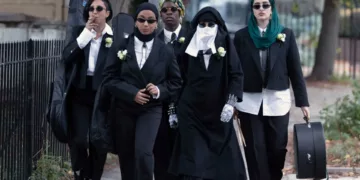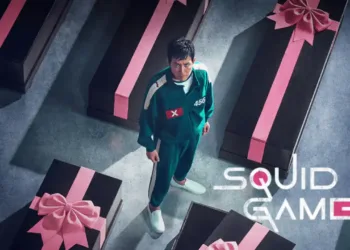We Are Lady Parts returns for a second season three years after debuting their infectious brand of punk rock on television. The show introduced viewers to an all-female Muslim band pursuing their musical dreams in London, with Amina serving as the unlikely frontwoman.
Season 1 brought the band together and saw them perform at local venues while navigating relationships and cultural expectations. In Season 2, Lady Parts is back in London after a summer of touring. They seek to record their debut album but face new challenges on their rise to stardom.
Will they stay true to their roots or sacrifice their values for fame? This season deepens the band’s journey as both musicians and individuals. Fans will love seeing how these memorable characters have evolved while maintaining the show’s winning mix of humor, heart, and kickass music.
We Are Lady Parts Shines in Season Two
Each member steps further into their own story of self-discovery. Amina emerges empowered in her “villain era,” bagging a dream job and finding her voice. Though humor remains, a subtler confidence surfaces—she knows her strengths and isn’t afraid to test boundaries.
Ayesha delves into the nuanced aspects of faith and sexuality. Dating a liberal partner presents understanding gaps, yet Ayesha explores her truth patiently. With care, the show suggests orthodoxy and queerness can both belong if one finds their way at their own pace.
Bisma takes her next step, balancing roles as an artist, mother, and woman of color. Faith Omole brings soul and feeling to a solo that lingers, as Bisma quietly asserts her multiplying facets deserve space to shine.
Saira faces hardship but stays determined. Struggles with housing and selling out only fuel her passion more. She meets a legend, sparking a song whose heartfelt resonance comes through Impey’s powerful performance.
Momtaz levels up too, navigating a changing landscape. Shorthouse depicts a mother figure learning where to support dreams without limiting them, her niqabs blooming as boldly as the women she cares for.
Each character’s music, beyond reflecting life’s frustrations, carries hope that another world is possible. Their layered journeys honor diversity within unity, suggesting freedom lies not in having one voice but in finding strength together through many.
Celebrating Their Voice
We Are Lady Parts returns with dynamic new music showcasing each band member’s spirit and talents. From Saira’s soulful vocals to Ayesha’s rhythmic drums, their sound has come into its own.
Fresh songs like “Glass Ceiling Feeling” empower with lyrics examining society’s limits. Saira pours her heart into describing dreams faced with barriers, inspiring listeners to push limits. The track’s music video poignantly tells its story through Saira navigating the music industry. Others, like “Malala Made Me Do It,” put a comedic twist on challenging norms through their love for the activist.
Lyrical themes relate to diverse experiences. “The Villain Anthem” reflects Amina’s newfound confidence through infectious synth melodies. Bisma shines on a folky number touching on cultural pride and motherhood. Their passion inspires them to explore identity through punk’s diverse lenses.
Musical numbers flow seamlessly into comedy and plots. Performances don’t feel detached but are integral to understanding each woman’s journey. A romantic ballad adds humor to Amina’s romance, while a country cover taps culture’s roots. Surreal scenes like freezing time mesh wildly with raw musical authenticity.
We Are Lady Parts amplifies unheard voices through memorable melodies. Pushing boundaries of what music can be, they bring light through celebration of their experiences, talents, and vision on their own terms.
Cultural Connection
The series shines in its portrayal of five Muslim female leads from varied backgrounds. Each woman embraces her identity fully while overcoming expectations. They inspire as role models navigating life, faith, art, and self-love.
Viewers relate to the characters’ journey of finding purpose and empowerment. Whether tackling anger, confusion, or passion, they face obstacles courageously as individuals. Saira’s housing troubles resonate with anyone struggling financially.
Fans appreciate tackling tough discussions meaningfully. The show explores feminism’s intersectionality, with representation mattering universally. It sparks thought around faith, culture, society, and being true to oneself.
Handling sexuality and cultural norms sensitively, the message is one of inclusion. People of all backgrounds deserve loving support systems. By spotlighting diverse stories authentically, creative works can educate and bring communities together.
We Are Lady Parts fills a need for nuanced Muslim female representation. It creates space for open dialog where few pop culture options exist. Most importantly, it reminds us that underneath differences beat hearts, wanting primarily to love and be loved, to find one’s people and one’s place in the world. The characters remind us of our shared humanity.
Lady Parts Take on the Recording Process
Returning for a second season, We Are Lady Parts finds the band members tackling their most ambitious project yet—recording their debut album. As they embark on capturing their music professionally for the first time, Lady Parts must also weigh difficult decisions about commercial priorities versus staying true to themselves.
Recording brings both exciting opportunities and unforeseen challenges. Securing studio time costs money the band doesn’t have, forcing them to consider less ideal funding options. An offer comes from an experienced producer, yet his mainstream pop background raises fears over possible influence. Financial needs clash with desires to maintain full creative control.
Meanwhile, the rise of a copycat group called Second Wife raises the stakes in the music scene. The younger band mimics Lady Parts’ style while omitting their bold Muslim and feminist identities. Facing this new threat, pressure mounts on Lady Parts to cut through with a clear message through their album.
Beyond industry issues, personal growing pains emerge. Band members find their voices strengthening in different ways. Bisma delves deeper into her mixed heritage and motherhood role. Ayesha grapples privately with coming-out decisions. Saira stands firm as the sole punk purist, distrusting any moves towards popularity.
We Are Lady Parts depicts art and identity as intertwined journeys. Though tensions inevitably arise between generations and worldviews, the heart of the story lies in a band’s collective struggle to stay true to their roots and purpose. Through turmoil, both external and internal, an underlying theme of empowerment through friendship and shared creativity emerges. Ultimately, Lady Parts affirms that, with support, our voices can rise above to inspire others.
Costumes and Comedy Come Together
We Are Lady Parts’ unique style shines through its visuals and humor. PC Williams’ Bafta-winning costumes play a key role in revealing each character. From Amina’s culturally inappropriate cowboy hat to Mumtaz’s upgraded niqabs, clothing underscores their self-expression journeys.
Comedy keeps the tone lively while tackling serious topics. Amina’s romantic pursuits prompt cringes and laughter as she navigates her “villain era.” Her neurotic nature provides narration with nervous energy. Interactions between opinionated Saira and laidback Bisma create amusing clashes of perspective.
Surreal touches maintain the anarchic punk spirit. Time freezes, and Malala’s cameo appearances feel appropriately eccentric. Absurd scenarios flow naturally from realistic situations, avoiding forced gags. Punchlines land, whether riffing on relationships or cultural expectations.
Laugh out loud moments to keep viewers constantly engaged. Quick wit and absurd premises surprise with every scene. Characters speak and act passionately on issues close to them. Yet humor arises from compassionate portrayals of humanity in all its messy complexity.
By balancing heart and hilarity so deftly, We Are Lady Parts makes important commentary thoroughly entertaining. Visual cues and comedic style reflect the characters’ rebellious rock and roll spirit.
We Are Lady Parts: A Joyfully Chaotic Second Adventure
Lady Parts returned this season with non-stop energy, churning out anthemic punk songs and lashing social issues with laughter-through-gritted-teeth irony. Yet for all its buzzsaw wit, the show retains heart, and heart is what makes it soar.
This season dove headfirst into recording challenges, financial stresses, and identity navigation, all while maintaining deeply felt character beats. Ayesha contemplated coming out, Saira battled for integrity over fame, and Bisma embraced new layers of herself. Through it all, they burned their bond, welding ambition and introspection into uplifting harmony.
But with six episodes versus last season’s six, some threads felt truncated. Saira’s housing woes barely registered resolution. And while musical highlights like “Glass Ceiling Feeling” sparked joy, more songs could have enriched the season’s flow.
Still, Nida Manzoor’s vision blazed as brightly as ever. Her storytelling bloomed with sneak attacks of absurdism alongside poignant familial scenes. Costumes popped, gags landed, and meaningful discussions subtly strengthened the whole. Whether dissecting corporate machination or casually representing diverse lived experiences, Lday Parts spreads empowerment through madcap grins.
When the final notes played, excitement grew for where these women’s futures may lead. Though some roads ahead stay misty, one thing is clear: the punk spirit coursing through We Are Lady Parts guarantees their journey will stay full of surprise, solidarity, and smash-hit anthems to come. Fans won’t want to miss what this riotous band of sisters does next.
The Review
We Are Lady Parts Season 2
Though some storylines felt prematurely cut, Manzoor's anarchic vision and her band of sisters more than justify continued investment. We Are Lady Parts proclaims its message with fist-pumping fanfare: representation matters, and music can spark revolution. Season 2 doubles down on empowerment through laughter-peppered rock.
PROS
- Strong and nuanced representation of diverse Muslim women characters
- Catchy original punk rock soundtrack
- Humorous and heartfelt storylines tackling important social issues
- Well-developed characters and their personal journeys
- Visual style and costume design enhance the punk aesthetic.
CONS
- Some storylines weren't fully resolved within six episodes.
- Could have benefited from 1-2 more episodes to flesh things out.
- Narrative pacing felt a bit rushed at times.




















































